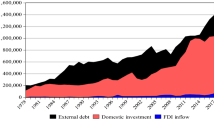Abstract
This paper estimates the nexus of inter-relationships between public and private external debts accumulation, capital accumulation and production with panel data for the period 1970–1988 from highly indebted developing countries clustered into three distinct regions: Latin-America, Asia-Pacific and Sub-Saharan Africa. The simultaneous equations' estimation results indicate that the full effects of the public and private external debts on GNP are small and of an opposite sign, whereas an increase in the GNP level raises substantially the public and private external debts. These findings support Bulow-Rogoff's (1990) proposition that the external debts of developing countries are not a primary cause of economic slowdown.
Similar content being viewed by others
References
Boyce, James K. “The Revolving Door? External Debt and Capital Flight: A Philippine Case Study.”World Development 20, no. 3 (March 1992): 335–49.
Bulow, Jeremy, andKenneth Rogoff. “Cleaning up Third World Debt Without Getting Taken to the Cleaners.”The Journal of Economic Perspectives 4, no. 1 (Winter 1990): 31–42.
Dooley, Michael P., andElhanan Helpman. “Tax Credits for Debt Reduction.”Journal of International Economics 32 (February 1992): 165–77.
Helpman, Elhanan. “Voluntary Debt Reduction: Incentives and Welfare.” In:Analytical Issues in Debt, ed. Jacob A. Frenkel, Michael P. Dooley and Peter Wickham, 279–310. Washington D.C.: International Monetary Fund, 1989.
IBRD.World Debt Tables 1990–91. Washington D.C., 1990.
IBRD.World Tables, 1989–90. Washington D.C., 1990.
IBRD.Social Indicators of Development. Washington D.C., 1990.
Kenen, Peter B. “Organizing Debt Relief: The Need for a New Institution.”Journal of Economic Perspectives 4, no. 1 (Winter 1990): 7–18.
Krugman, Paul R. “Market-Based Debt-Reduction Schemes.” InAnalytical Issues in Debt, ed. Jacob A. Frenkel, Michael P. Dooley, and Peter Wickham, 258–278. Washington D.C.: International Monetary Fund, 1989.
Levy, Amnon. “An Analysis of the Potential Externalities Affecting the Borrowing Behaviour of Developing Countries.”Australian Economic Papers 31, 58 (June 1992): 164–176.
Levy, Amnon, Khorshed Chowdhury, and E. Wilson. “Are the External Debts of Developing Countries a Symptom or a Cause of Economic Slowdown?”The Indian Economic Journal, Conference volume (1991): 57–72.
Sachs, Jeffrey D. “A Strategy for Efficient Debt Reduction.”Journal of Economic Perspectives 4, no. 1 (Winter 1990): 19–29.
Sen, Amartya Kumar.On Economic Inequality. Oxford: Clarendon Press, 1973.
Yitzhaki, Shlomo. “Relative Deprivation and the Gini Coefficient.”Quarterly Journal of Economics 93 (May 1979): 321–324.
Author information
Authors and Affiliations
Rights and permissions
About this article
Cite this article
Levy, A., Chowdhury, K. An integrative analysis of external debt, capital accumulation and production in Latin America, Asia-Pacific and Sub-Saharan Africa. J Econ Finan 17, 105–119 (1993). https://doi.org/10.1007/BF02920034
Issue Date:
DOI: https://doi.org/10.1007/BF02920034




